Nasality review
Velum opening and oral-nasal airflow
Bibliographic information: When referring to this document, use the following bibliographic reference:-
Mannell R.H., (2013), Velum opening and oral-nasal airflow, Macquarie University
Review of "nasality"
Nasality, in the most commonly used sense of the word, refers to "a number of auditorily distinguishable voice qualities." (Laver, 1980, p70). These voice qualities result in the main from various settings of the velum and pharynx (ie. Laver's "Velopharyngeal settings", ibid.). It must be stressed then that "nasality" is an auditory phenomenon which can be produced by quite different articulatory phenomena.
It has often been assumed that nasality is simply a function of velic opening, but this ignores the complex interactions between the muscles that are involved in opening the velum and other parts of the vocal tract to which those same muscles are attached (see figure 1). The two main muscles that assist in opening the velum are the palatoglossus and the palatopharyngeus muscles. It must be remembered, however, that the lowering of the velum may in some cases not be accompanied by the active contraction of the muscles but may be due to the relaxation of the muscles which raise the velum. The lowering of the velum in such cases would be achieved by the action of gravity. The choice of which mechanism, or combination of mechanisms are used in velic opening in various contexts varies from speaker to speaker and appears to be due to idiosyncratic habitual articulatory programming.
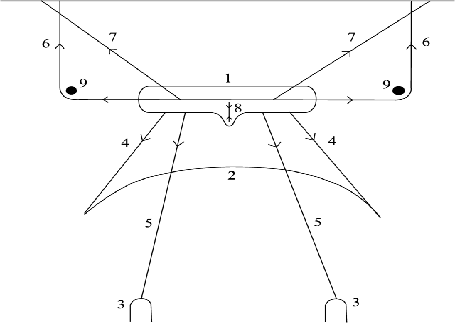
Figure 1: Schematic diagram of the action and location of the velopharyngeal muscles, seen from behind (adapted from Laver 1980)
1. Soft palate, 2. Tongue, 3. Thyroid cartilage, 4. Palatoglossus muscle, 5. Palatopharyngeus muscle, 6. Palatal tensor muscle, 7. Palatal levator muscle, 8. Azygous uvulae muscle, 9. Hamular process of the pterygoid bone, 10. Skull
The palatoglossus muscle is attached to the soft palate at one end and to the tongue at the other end. It can be used to lift the tongue when the soft palate is braced or it can lower the velum when the tongue is braced. Perfectly rigid bracing of either body is rarely achieved in continuous speech and so raising of the tongue tends to cause the velum to be lowered below its "neutral" position whilst opening of the velum can cause the tongue to be raised a little. For this reason speech sounds produced with high back tongue constrictions (where the tongue most closely approaches the velum, eg. /u:, o:/) tend to be produced by some speakers with greater velic opening (and thus greater nasal airflow) than those produced with a lower tongue position. Other speakers, on the other hand, may maintain a tense palatoglossus and so when the tongue is lowered (by various extrinsic tongue muscles) the palatoglossus acts as a more or less rigid link between the tongue and the velum, and the velum (if unbraced) is dragged down with the tongue. Contraction of the palatoglossus muscle also has the effect of approximating (bringing closer together) the sides of the front faucal arch (which, as we will see below, also can contribute to the auditory sensation of "nasality").
The perception of "nasality" in speech is highly dependant on context. A nasalised vowel is expected adjacent to a nasal consonant and so when it occurs the "nasality" is ignored. A non-nasalised vowel next to a nasal consonant, or a nasalised vowel which is not adjacent to a nasal consonant would both be likely to be perceived as "nasal" (the first due to hypo-nasality and the second due to hyper-nasality) as they would both deviate from the expected norm. For example, the vowel in /ma:m/ would certainly be nasalised (high nasal airflow and s.p.l.) but as this is expected the vowel would not be perceived as being "nasal".
The palatopharyngeus muscle is attached to the soft palate at one end and to the larynx (thyroid cartilage) at the other end. By similar mechanisms to those mentioned above, lowering the velum can cause the raising of an insufficiently braced larynx, whilst any raising of the larynx involving the use of that muscle may cause some lowering of the velum. In other words, velum opening may also be related to certain laryngeal settings and this can in turn affect the vibration of the vocal folds and the resultant source spectrum and fundamental frequency. Contraction of the palatopharyngeus muscle also approximates the sides of the back faucal arch.
The obvious consequence of a lower velum is an increase in the area of the opening of the nasal cavity. This tends to result in increased nasal airflow (assuming an unblocked nose due to colds etc.). Such an increase in nasal airflow will also occur if the oral opening decreases (eg. as it does for the higher tongue position of the high vowels /i:, u:, o:/). If "nasality" is assumed (for the moment) to relate to the degree of nasal cavity participation then the important factor seems to be the ratio of the cross-sectional area of the nasal opening over that of the oral opening.
The rate of velic movement tends to be related to changes in speech rate so that as the speech rate increases the coarticulatory influence of nasal speech sounds (eg. /m, n/) on adjacent phonemically non-nasal speech sounds increases. In other words, for increasing rate of articulation, a nasal speech sound must be anticipated earlier (ie. the velum opening must commence earlier) and the closing of the velum (or return to its neutral or normal position) is completed later following a NASAL speech sound. "Earlier" and "later" do not here refer to absolute time, but to the point in the utterance at which the opening or closing of the velum occurs relative to the point at which closing is either required (at the onset of a nasal phoneme) or is no longer required (at the offset of a nasal phoneme).
In normal "non-nasalised" speech the velum may be held open slightly and deviations from this "normal" or "neutral" position may be perceived as "nasality". Nasal airflow may give rise to speech judged to be "nasalised", but it need not. Further, nasal airflow is not an essential prerequisite for the production of auditorily "nasalised" speech. Nasality also often refers to sounds produced without any airflow through the nasal chamber at all. The most familiar example of this is the perception of nasality when the speaker has a blocked nose (eg. cold, 'flu, etc.). This reduction in nasal airflow from the neutral position is perceived to be "nasal". Many speakers of Australian English who are perceived to be "nasal" actually are hypo-nasal (low nasal airflow) rather than the expected hyper-nasal (high nasal airflow).
The relationship between nasal sound pressure level ("nasal s.p.l." is the level of the sound emitted from the nostrils) and both nasal airflow and perceived "nasality" is quite complex. It is possible to have a high level of airflow and a low level of s.p.l. in either the oral or the nasal cavity (this is of course best demonstrated by quite breathing). It is also possible (and extremely common) for sound to be transmitted through the soft palate into the nasal cavity even when the velum is completely closed. This excites nasal cavity resonances and is perceived as a highly damped "nasality". This type of effect tends to reduce the correlation between nasal s.p.l. and perceived nasality.
Nasality is commonly associated with nasal cavity resonances. However, it can also be linked to a special kind of resonance which results when a "cul-de-sac" or side chamber is opened off the main resonance chamber and where its only opening is into the main resonance chamber. In practice it is possible for either the oral or the nasal cavity to act as a side chamber to the other. If the narrowest oral constriction is wider than the cross-sectional area of the nostrils then the nasal cavity acts as the side chamber and vice versa. In other words the cross-sectional areas of the oral and nasal openings and exits are all important in the determination of which chamber will act as the side-chamber. As Laver puts it "whichever cavity has the smaller exit becomes the side chamber, provided that the exit is itself smaller than the entry to the cavity". (ibid, p83)
When nasal consonants /m, n, ng/ etc. are produced the side chamber is clearly the oral cavity as far forward as the oral closure. The velar nasal consonant /ng/ produces a small chamber behind the back of the tongue and under the uvula which can act as a (very short) side chamber.
The tongue itself also vibrates and can excite resonances in the front of the mouth. In other words, the nasal consonants /m, n, ng/ consist of nasal cavity resonances, oral (or pharyngeal in the case of the small cavity behind the velar closure) anti-resonances (or zeroes) in the side-chamber cavity posterior to the oral closure, and also (mainly in the case of the velar consonant) oral resonances anterior to the oral closure caused by the vibration of the tongue. Segmental nasality is clearly a function of the degree of nasal vs oral opening and this is therefore likely to also be the case for supra-segmental nasality caused by the coarticulatory effect of movement between the individual's "normal" or pervasive setting and the segmental nasal setting.
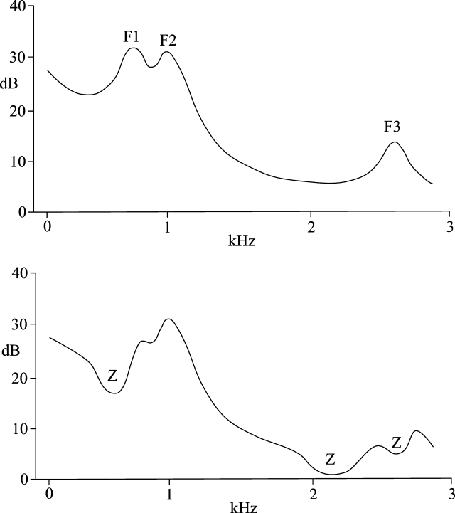
Figure 2: An example of the effects of vowel nasalisation on the vowel spectrum.
The spectrum envelopes of a normal [a] and a nasalised [a] are plotted as derived from spectral sections. The first three formants are labeled in the normal vowel: reductions in spectrum level in the nasalised vowel, presumably because of the addition of zeroes to the vocal tract response, are indicated by "z". (adapted from Pickett 1980)
In figures 3 to 5 we can compare the effect of preceding oral and nasal consonants. In figure 3 the preceding consonant is /w/ which is a labial-velar approximant with a distinct bilabial approximation. In the case of figure 4 the preceding consonant is /b/ which is a bilabial oral stop. In figure 5 the preceding consonant is /m/ which is a bilabial nasal stop. In the case of /ba:/ the preceding consonant must be produced with a closed velum (a requirement for effective oral stop production). This will generally result in a following vowel unaffected by antiresonances resulting from an open velum. As a consequence the first to major spectral resonance peaks are clearly defined. In the case of the /w/ in /wa:/ the degree of opening of the velum is optional (as velum opening in non-contrastive in English for approximants). The very close similarity of the initial part of the vowel spectrum in /wa:/ to that in /ba:/ suggests that /wa:/ was also articulated with a closed velum. Finally, in figure 5 the vowel spectrum is taken from the start of the vowel target shortly following after the /m/. Significant velum opening is compulsory for correct articulation of a nasal stop. The spectrum in the vicinity of F1 of the early part of the vowel is significantly affected by a nasal antiresonance or zero indicating that velum opening persisted significantly into at least the start of the vowel.
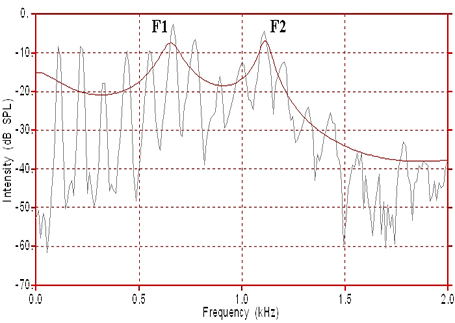
Figure 3: This figure displays the spectrum of an /a:/ vowel in the nonsense word "waa" spoken by a male speaker of Australian English.
The spectrum consists of a detailed (FFT) spectrum showing individual spectral harmonics overlaid with a smoothed (LPC) spectrum (in red) which more clearly displays the first two resonance peaks (F1 and F2) for this vowel. Note that the F1 and F2 peaks are clear and prominent. Listen to the audio file below to hear the utterance.
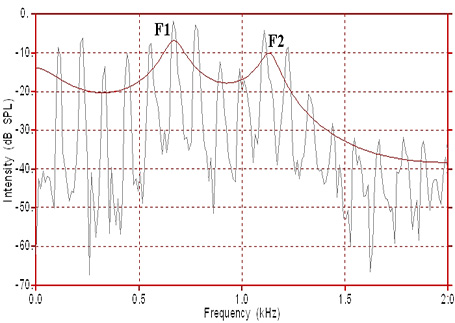
Figure 4: This figure displays the spectrum of an /a:/ vowel in the word "bar" spoken by a male speaker of Australian English.
The spectrum consists of a detailed (FFT) spectrum showing individual spectral harmonics overlaid with a smoothed (LPC) spectrum (in red) which more clearly displays the first two resonance peaks (F1 and F2) for this vowel. Note that the F1 and F2 peaks are clear and prominent. Listen to the audio file below to hear the utterance.
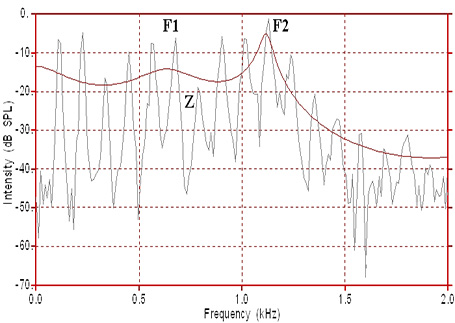
Figure 5: This figure displays the spectrum of an /a:/ vowel in the word "ma" spoken by a male speaker of Australian English.
The spectrum consists of a detailed (FFT) spectrum showing individual spectral harmonics overlaid with a smoothed (LPC) spectrum (in red) which more clearly displays the first two resonance peaks (F1 and F2) for this vowel. Note that the F2 peak is clear and prominent but that the F1 peak is almost absent as a consequence of a spectral zero that almost coincides with it. Listen to the audio file below to hear the utterance.
Non-segmental "nasalisation" of a segment due to voice quality settings (pervasive nasality) does not obligatorily require that the nasal cavity be the anti-resonance producing side chamber although it most often is (and can generally be assumed to be the case in this experiment). There are possible side chambers in the lower pharynx below the epiglottis, in the upper larynx (especially during raised larynx conditions), and between the faucal pillars (remembering that the front and back faucal arches are approximated by the palatoglossus and palatopharyngeus muscles respectively).
The nasal resonances have been measured at about 200-300 Hz, 1000 Hz and 2000 Hz. The bandwidth of the lower resonance is quite narrow (~300 Hz) increasing to about 1000 Hz by the higher resonances. Anti-resonances which result from a nasal side cavity are paired with the nasal resonances and absorb energy at those frequencies causing dips or zeroes in the resultant spectrum. In nasalised segments there is usually an anti-resonance just above the nasal formant and usually in the region of the first formant of any nasalised vowel. The low frequency nasal formant tends to appear in the spectra of both nasal and nasalised segments, whilst the anti-resonances tend to broaden the bandwidths of (dampen) some formants and cause a general spectral flattening or absorption of acoustic energy at those frequencies.
The nasal consonants resemble oral stops in the mechanism and rate of oral closure and release and for this reason are often referred to as nasal stops. For this reason the spectrogram of a nasal consonant shows a sudden onset and offset as well as transition patterns similar to the homorganic (same place of articulation) oral stop. Their low frequency nasal murmur tends to be of a much higher frequency than that during the occlusion of a voiced stop and further there is often a visible (but weak) second formant which is never seen in a voiced stop. Also the low frequency murmur extends backwards and forwards into the adjacent vowels in a nasal but not with a voiced stop. This is accompanied in the nasalised vowels by a damped first formant.
Pervasive, intrinsic and contextual nasality
Whilst correctly speaking the term "nasality" refers to the perceptual phenomenon described above, the term is also very often used loosely to refer to higher than normal levels velum opening and to resulting patterns of nasal airflow and sound pressure.
Pervasive nasality refers to a speaker who, either habitually or for some other neural or peripheral reason, sounds excessively nasal across all of their speech sounds (possibly excluding their oral stops and fricatives). The term may also be applied to people whose velum is, on average, more open than the community norm (and this is likely to be highly correlated with perceptual nasality). Pervasive nasality might also be applied to whole speech communities for whom either velum opening or perceptual nasality is higher than the average relative to other speech communities or from the perspective of speakers of another speech community whose average (or ambient) nasality is lower. In the workshop the phonetically balanced Rainbow passage allows us to compare the relative degrees of pervasive velum opening from subject to subject.
Contextual Nasality refers to the tendency of sounds adjacent to phonemes with obligatory nasality (eg. nasal stops) to have a higher degree of velum opening, as a consequence of coarticulation, than is the case in other contexts. In most cases this does not result in a higher level of perceived nasality as a more open velum is expected in these contexts. For some speakers, however, vowel sounds adjacent to nasal consonants have even more velum opening than is the norm and because of this these vowels sound nasal even though they are adjacent to a nasal consonant. Mitchell and Delbridge (1965) describe some speakers of Australian English (mostly broad speakers of Australian English) as having audible nasality specifically in the context of nasal consonants, but not in other contexts (see the Phonetics and Phonology topic entitled "Impressionistic Studies of Australian English Phonetics" for more information). In the workshop the "chop barb" (etc.) phrases allow us to examine contextual patterns of velum opening. The Naomi passage, with its greater number of nasal consonants, allows us to compare the extent to which some subjects have greater degrees of contextual velum opening by comparing the the results for the Naomi passage against the results for the Rainbow passage. Also, it might be assumed that contextual effects on velum opening adjacent to nasal consonants might be greater for rapid than for slower speech (because it spreads across more phonemes). A comparison of the fast and slow readings of these passages might reveal such a trend but it has proven difficult to record fast readings of these passages that are not affected by significant levels of dysfluency (e.g. hesitations, etc.).
Intrinsic Nasality refers to the tendency of some vowels (but possibly also some approximants) to have a higher degree of velum opening than is the case for other vowels. This may, or may not, result in higher perceived nasality depending upon whether this effect and particularly the degree of that effect is an expected effect for the speaker's speech community. Further, it is not unusual for different members of a single speech community to have idiosyncratic habitual patterns of intrinsic velum opening. The sentences of the type "Yee bees feed trees" allow us to compare the relative extent of velum opening for a selection of vowel phonemes and to determine the extent of individual differences in these patterns.
Direct and indirect measures of velum opening
There are a number of ways of directly measuring velum opening. This might be done using an naso-endoscope passed through the nostrils and positioned above the velum opening. This technique is demonstrated in a series of short video clips. The main problem with this technique is the difficulty in consistent positioning of the endoscope and the problem of applying an appropriate scale to measurements taken from the resulting video. Another method might be to examine xray images and movie sequences, but again there is the problem of scale during subsequent measurements. Careful examination of a series of xray movies on this site will demonstrate the dynamics of velum opening. Ultrasound can also be used to track velum movement and is being used increasingly in clinical and research contexts.
Indirect measures of velum opening usually involve measuring the ratio of oral to nasal airflow or the ratio of oral to nasal sound pressure and implying velum opening from the results. There are a number of inherent errors in such indirect methods. For example, changes in the ratio of oral-nasal airflow is not just a consequence of changes in velum opening but also a consequence of changes in the degree of oral opening. For example, high vowels have a higher degree of stricture than low vowels and rounded vowels usually have a lesser degree of lip opening than unrounded vowels. In spite of these shortcomings such indirect measures are used in the oral-nasal airflow workshop.
Bibliography
- Clark J.E. & Yallop, C., An introduction to Phonetics and Phonology, Oxford: Blackwell.
- Hardcastle W.J., Physiology of Speech Production, London: Academic Press, 1976, pp 120-124.
- Laver J. The Phonetic Description of Voice Quality, Cambridge University Press, 1980. pp 68-92.
- Pickett J.M, The Sounds of Speech Communication, Baltimore: University Park Press, 1980, pp 121-131.
Please note that Pickett is referred to in the text above, but is not required reading for this topic. The Hardcastle and Laver materials are available to registered students as advised previously.
Content owner: Department of Linguistics Last updated: 12 Mar 2024 10:41am
